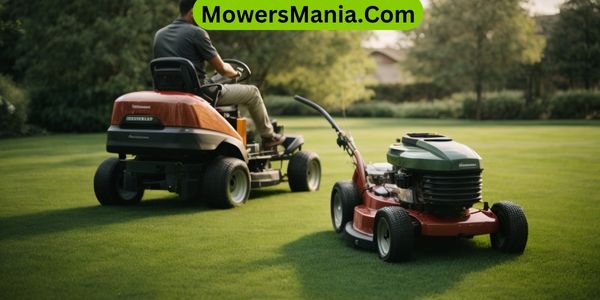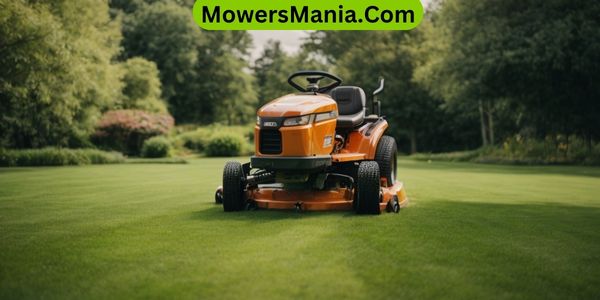Are you confused about the difference between a lawn mower and a grass cutter? Well, let’s clear things up for you!
In this article, we’ll break down the distinctions between these two commonly used tools for maintaining your yard. From power sources to cutting mechanisms, we’ll cover it all.

So, whether you’re a beginner or just curious, keep reading to understand which one is best suited for your lawn care needs.
Power Source
When choosing between a lawn mower and a grass cutter, you may wonder which power source suits your needs. Both types of equipment can be powered by either electricity or gasoline.
Electric lawn mowers and grass cutters are ideal for smaller yards because they’re lightweight, quiet, and easy to maneuver.
With an electric power source, you don’t have to worry about gas or oil, making them more environmentally friendly. They also require less maintenance and start with the push of a button.
On the other hand, gasoline-powered lawn mowers and grass cutters are better suited for larger yards or areas with thick, overgrown grass. They provide more power and can handle tougher cutting tasks.
However, they require regular maintenance, including oil changes and spark plug replacements. They also tend to be heavier and louder compared to their electric counterparts.
Ultimately, your choice of power source will depend on the size of your yard and the type of grass or vegetation you need to cut.
Cutting Mechanism
To understand the difference between a lawn mower and a grass cutter, it’s important to consider their cutting mechanisms. The way these machines cut grass can greatly impact their performance and the final result of your lawn.
Here are three key points to help you understand the cutting mechanisms of lawn mowers and grass cutters:
Understanding the cutting mechanisms of lawn mowers and grass cutters can help you make an informed decision when choosing the right tool for your lawn care needs.
Cutting Height Adjustment

Adjusting the cutting height of your lawn mower or grass cutter allows you to customize the length of your grass. Whether you prefer a neatly manicured lawn or a slightly longer, more natural look, being able to adjust the cutting height gives you control over the appearance of your lawn.
Most lawn mowers and grass cutters come with adjustable cutting height options. Depending on the model, you can usually choose from several settings, ranging from a very short cut to a longer, more relaxed cut.
The height adjustment mechanism is usually located on the wheels or the deck of the machine. By simply moving a lever or turning a knob, you can easily change the cutting height to suit your preferences.
When adjusting the cutting height, it’s important to consider the type of grass you have and the season.
Different grass species have different optimal heights for healthy growth and appearance. For example, cool-season grasses like Kentucky bluegrass and tall fescue generally do well when cut to a height of 2 to 3 inches.
On the other hand, warm-season grasses such as Bermuda grass and zoysia grass thrive when cut shorter, around 1 to 2 inches.
Terrain Adaptability
To ensure optimal performance on various terrains, your lawn mower or grass cutter needs to adapt and navigate smoothly.
Here are three key factors to consider when it comes to terrain adaptability:
- Traction: A good lawn mower or grass cutter should have excellent traction to prevent slipping and sliding on uneven or sloped terrains. Look for models with sturdy wheels or tires that provide a firm grip on the ground.
- Maneuverability: The ability to maneuver easily around obstacles is crucial for maintaining a well-groomed lawn. Opt for machines that have a tight turning radius and are lightweight, allowing you to navigate effortlessly through tight spaces and corners.
- Adjustable Height: Different terrains require different cutting heights to achieve the desired results. Choose a lawn mower or grass cutter that offers adjustable cutting height options, allowing you to adapt to various grass lengths and terrain conditions.
Maintenance and Storage

When it comes to maintaining and storing your lawn mower or grass cutter, there are a few key steps you need to follow.
Proper maintenance ensures that your equipment stays in good condition and performs optimally, while proper storage helps prolong its lifespan.
Here are some essential maintenance and storage tips for your lawn mower or grass cutter:
| Maintenance Tips | Storage Tips | Safety Tips |
|---|---|---|
| Regularly clean the | Store your equipment | Always wear protective |
| blades and remove any | in a cool and dry | gear, including goggles |
| debris to prevent | place to avoid rust | and ear protection |
| clogging and improve | and corrosion. | when operating |
| cutting efficiency. | your equipment. | |
| Check the oil, fuel, | Keep your equipment | Disconnect the spark |
| and air filters regularly | covered or protected | plug wire before |
| and replace them as | from dust, dirt, and | performing any |
| needed. | moisture. | maintenance tasks. |
Frequently Asked Questions [FAQs]
How Does the Power Source Affect the Performance of a Lawn Mower or Grass Cutter?
When it comes to the performance of a lawn mower or grass cutter, the power source plays a crucial role. It affects how efficiently the machine can cut the grass and the overall effectiveness of the tool.
Can the Cutting Mechanism of a Lawn Mower or Grass Cutter Affect the Quality of the Grass Cut?
Yes, the cutting mechanism of a lawn mower or grass cutter can affect the quality of the grass cut. It’s important to choose a machine with sharp blades and the right cutting height for optimal results.
Is It Easy to Adjust the Cutting Height on a Lawn Mower or Grass Cutter?
Adjusting the cutting height on a lawn mower or grass cutter is easy. You can simply use the provided adjustment knobs or levers to raise or lower the cutting deck to your desired height.
Are Lawn Mowers or Grass Cutters Suitable for All Types of Terrains?
Are lawn mowers or grass cutters suitable for all types of terrains? Yes, they both can handle various terrains like flat lawns, slopes, and uneven surfaces. You can choose the one that suits your needs.
What Are Some Important Maintenance and Storage Tips for Lawn Mowers and Grass Cutters?
To properly maintain and store your lawn mower or grass cutter, there are a few important tips to keep in mind. Regularly clean the blades, check the oil and fuel levels, and store in a dry, protected area.
Conclusion
In conclusion, while both lawn mowers and grass cutters serve the purpose of trimming grass, there are significant differences between the two.
Lawn mowers are powered by electricity or gasoline and have a blade that cuts the grass evenly at various heights.
On the other hand, grass cutters are manually operated tools with a rotating nylon string that cuts grass at a fixed height.
Understanding these distinctions can help you choose the right equipment for your lawn care needs.



